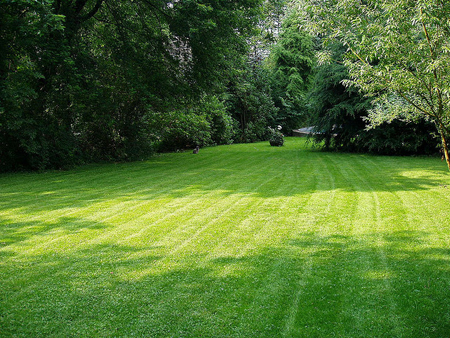If your lawn is looking a bit patchy as the summer draws to a close, it could be time for a complete overhaul. Autumn is the ideal time to lay down new turf so that by next year you’ll have a lush, green lawn to enjoy when the warmer weather returns.

1 - Choose Your Timing
Autumn is the perfect time to lay new turf as it needs soft, moist soil so it can properly take root, as well as a certain amount of sunshine above. Autumn provides the best proportion of both of these things – it’s warmer than winter, but wetter than summer. You could lay your turf in spring, but the risk of a drought or hosepipe ban in the coming summer months means that autumn is naturally the better choice.
2 - Prepare the Ground
Taking steps to prepare the ground is as important, and sometimes more time consuming, than the actual laying process itself:
- Skim off any old grass, ensuring you go down deep enough to remove any roots. Also dig out any large stones
- Fork over the site to loosen the soil and expose any hidden stones
- At this stage add an appropriate lawn fertiliser to help your turf take root and stay healthy. Once you’ve applied your fertiliser, flatten the soil down – you could walk on it, or if you have a large lawn you could consider laying down a board and then putting pressure onto it. You need to be able to walk on it without leaving footprints.
- Next, light raking will gently break up the top crumbs of soil to give the turf a soft enough surface for the grasses to take root.
3 - Laying the Turf
Now you’re ready to lay down your turf. This is a relatively straightforward procedure, but there are a few things you can do to ensure that you get the best results:
- Ensure a tight fit between the sheets and butt the edges firmly together
- A brickwork pattern is a good idea rather than laying them out like a checkerboard
- Pat each sheet down gently but firmly with a rake – this will ensure good contact with the soil underneath
- Water soon after laying to keep the turf from cracking or shrinking
4 - Aftercare - The First Few Months
Choosing to lay turf in autumn will usually ensure that there will be a good enough natural water supply, however it’s important to do this yourself if the weather becomes unseasonably warm and dry. You should monitor for emerging signs of moss or weeds after 6 months or so, especially if you skimmed off old grass first, and if you see any signs then that’s the time to consider using a product like lawn sand to combat these emerging problems. It’s also a good idea not to walk on your turf for a few weeks, longer if you can avoid it, until it has had a chance to properly take root.
If you want to get some more advice on laying new turf, give Proctors a call on 0117 311 1217 to discuss our range of lawn care products.























